Eco-Leadership in Non-Governmental Organizations: A Detailed Report
VerifiedAdded on 2023/04/17
|13
|2613
|305
Report
AI Summary
This report examines eco-leadership within non-governmental organizations, focusing on Direct Aid, a humanitarian aid organization. It explores the concept of eco-leadership, defining it as a network of distributed leaders and discussing its relevance in addressing environmental and social issues. The report delves into Direct Aid's background, mission, and current status, highlighting its commitment to aiding vulnerable communities. It then identifies four key qualities of eco-leadership: connectivity and interdependence, systemic ethics, leadership spirit, and organizational belonging. Each quality is discussed in detail, with examples of how Direct Aid can implement these principles. The report also touches upon the environmental social movement and its influence on NGOs. It emphasizes the importance of distributed leadership, ethical practices, community engagement, and inclusive leadership for NGOs to effectively address challenges and achieve their goals. The report concludes by underscoring the significance of eco-leadership in fostering sustainable and impactful organizational practices within the non-profit sector.
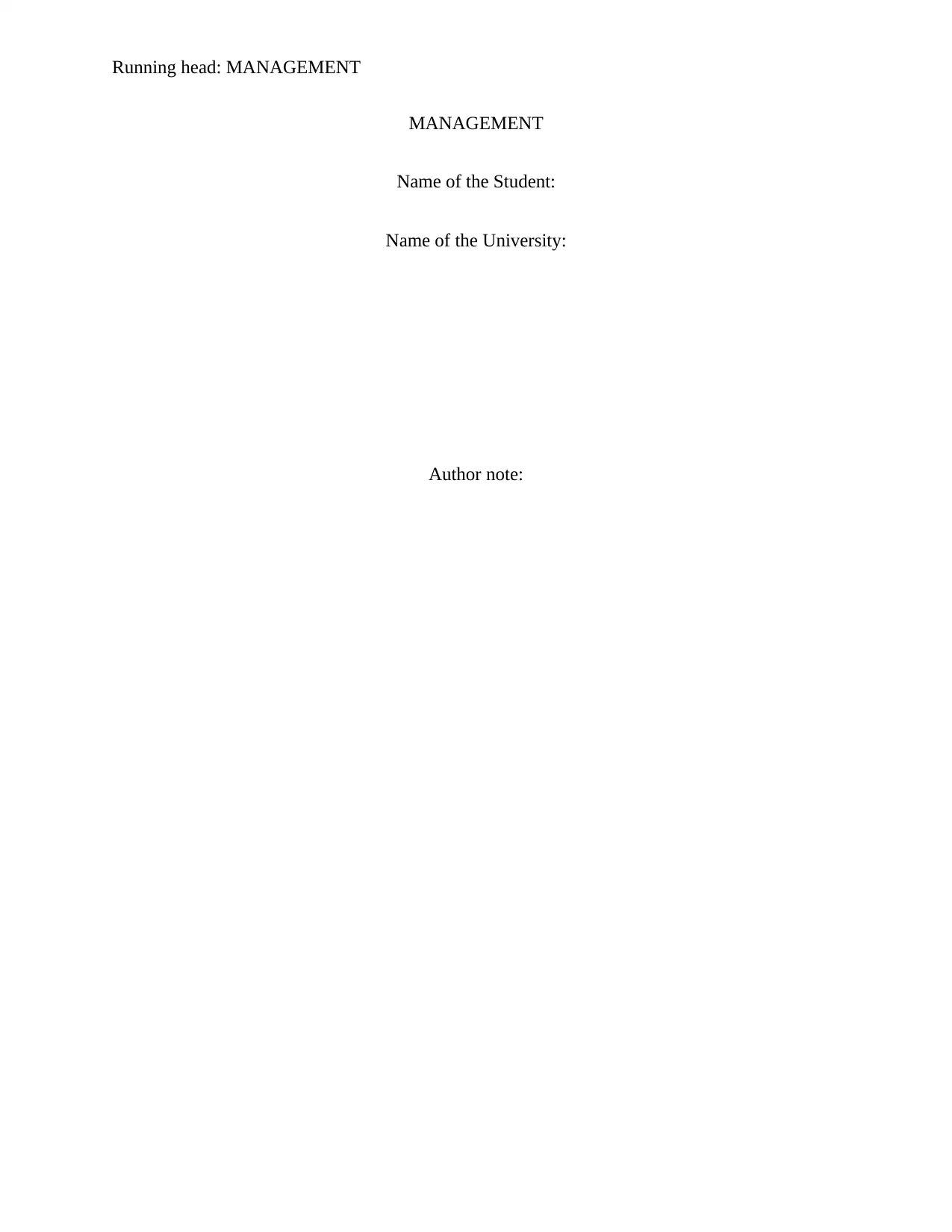
Running head: MANAGEMENT
MANAGEMENT
Name of the Student:
Name of the University:
Author note:
MANAGEMENT
Name of the Student:
Name of the University:
Author note:
Paraphrase This Document
Need a fresh take? Get an instant paraphrase of this document with our AI Paraphraser
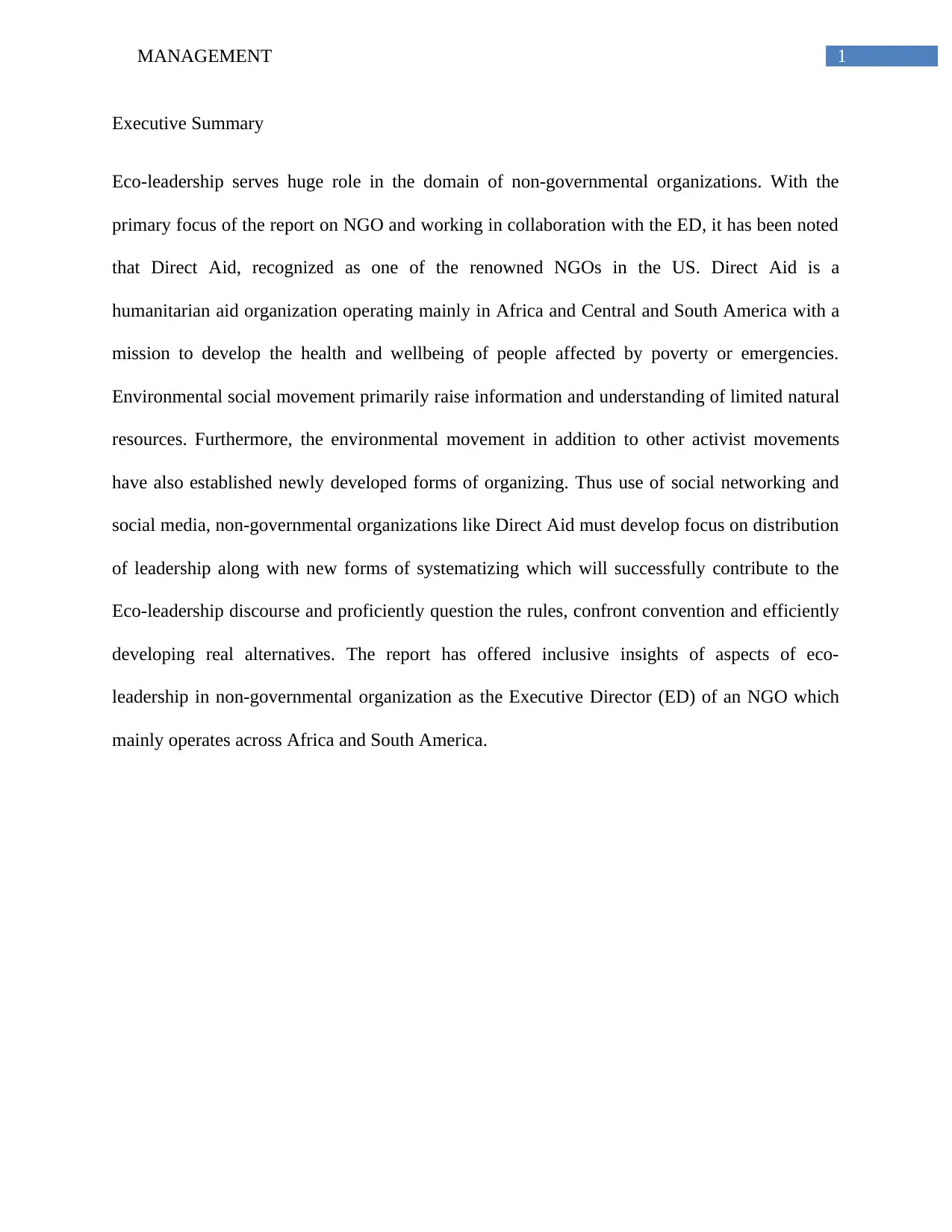
1MANAGEMENT
Executive Summary
Eco-leadership serves huge role in the domain of non-governmental organizations. With the
primary focus of the report on NGO and working in collaboration with the ED, it has been noted
that Direct Aid, recognized as one of the renowned NGOs in the US. Direct Aid is a
humanitarian aid organization operating mainly in Africa and Central and South America with a
mission to develop the health and wellbeing of people affected by poverty or emergencies.
Environmental social movement primarily raise information and understanding of limited natural
resources. Furthermore, the environmental movement in addition to other activist movements
have also established newly developed forms of organizing. Thus use of social networking and
social media, non-governmental organizations like Direct Aid must develop focus on distribution
of leadership along with new forms of systematizing which will successfully contribute to the
Eco-leadership discourse and proficiently question the rules, confront convention and efficiently
developing real alternatives. The report has offered inclusive insights of aspects of eco-
leadership in non-governmental organization as the Executive Director (ED) of an NGO which
mainly operates across Africa and South America.
Executive Summary
Eco-leadership serves huge role in the domain of non-governmental organizations. With the
primary focus of the report on NGO and working in collaboration with the ED, it has been noted
that Direct Aid, recognized as one of the renowned NGOs in the US. Direct Aid is a
humanitarian aid organization operating mainly in Africa and Central and South America with a
mission to develop the health and wellbeing of people affected by poverty or emergencies.
Environmental social movement primarily raise information and understanding of limited natural
resources. Furthermore, the environmental movement in addition to other activist movements
have also established newly developed forms of organizing. Thus use of social networking and
social media, non-governmental organizations like Direct Aid must develop focus on distribution
of leadership along with new forms of systematizing which will successfully contribute to the
Eco-leadership discourse and proficiently question the rules, confront convention and efficiently
developing real alternatives. The report has offered inclusive insights of aspects of eco-
leadership in non-governmental organization as the Executive Director (ED) of an NGO which
mainly operates across Africa and South America.
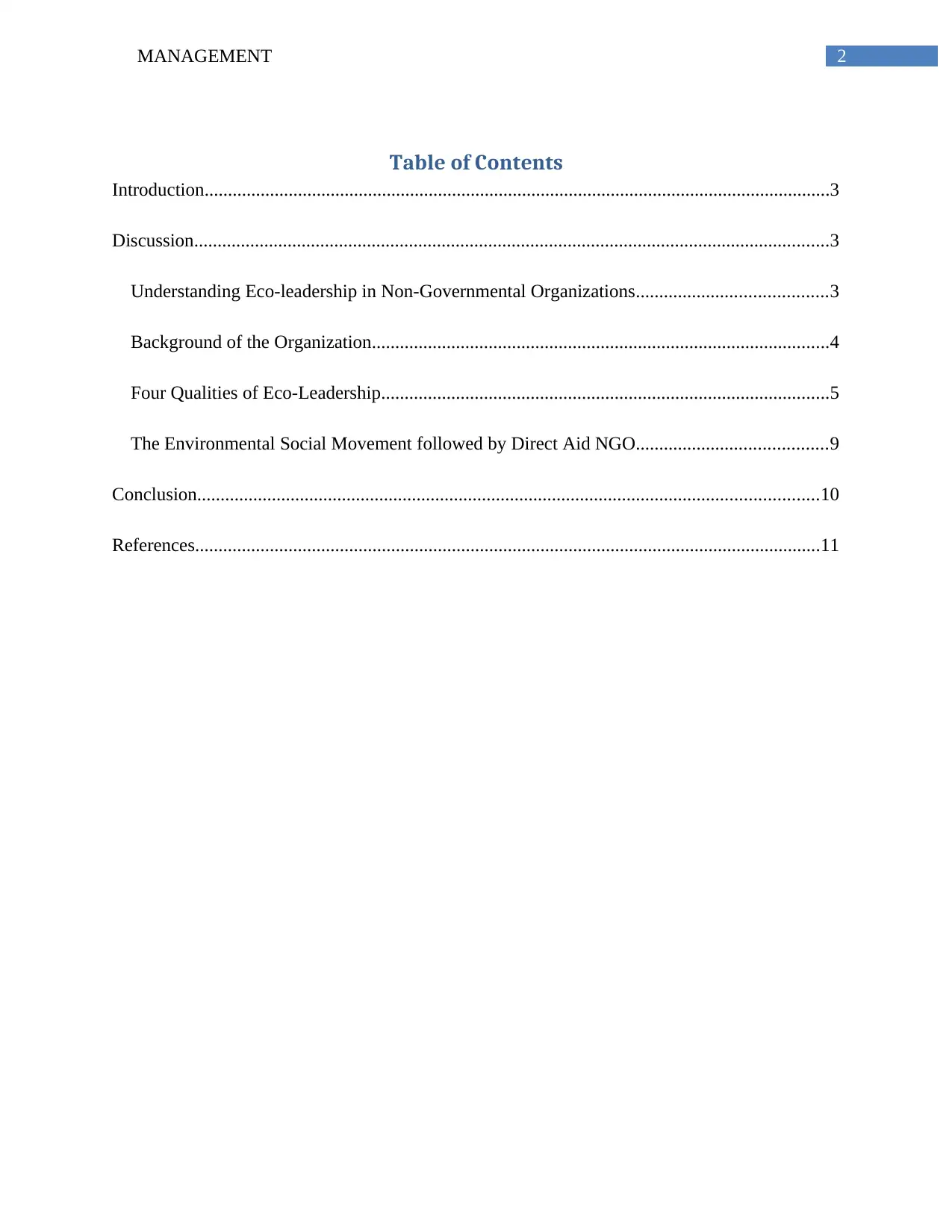
2MANAGEMENT
Table of Contents
Introduction......................................................................................................................................3
Discussion........................................................................................................................................3
Understanding Eco-leadership in Non-Governmental Organizations.........................................3
Background of the Organization..................................................................................................4
Four Qualities of Eco-Leadership................................................................................................5
The Environmental Social Movement followed by Direct Aid NGO.........................................9
Conclusion.....................................................................................................................................10
References......................................................................................................................................11
Table of Contents
Introduction......................................................................................................................................3
Discussion........................................................................................................................................3
Understanding Eco-leadership in Non-Governmental Organizations.........................................3
Background of the Organization..................................................................................................4
Four Qualities of Eco-Leadership................................................................................................5
The Environmental Social Movement followed by Direct Aid NGO.........................................9
Conclusion.....................................................................................................................................10
References......................................................................................................................................11
⊘ This is a preview!⊘
Do you want full access?
Subscribe today to unlock all pages.

Trusted by 1+ million students worldwide
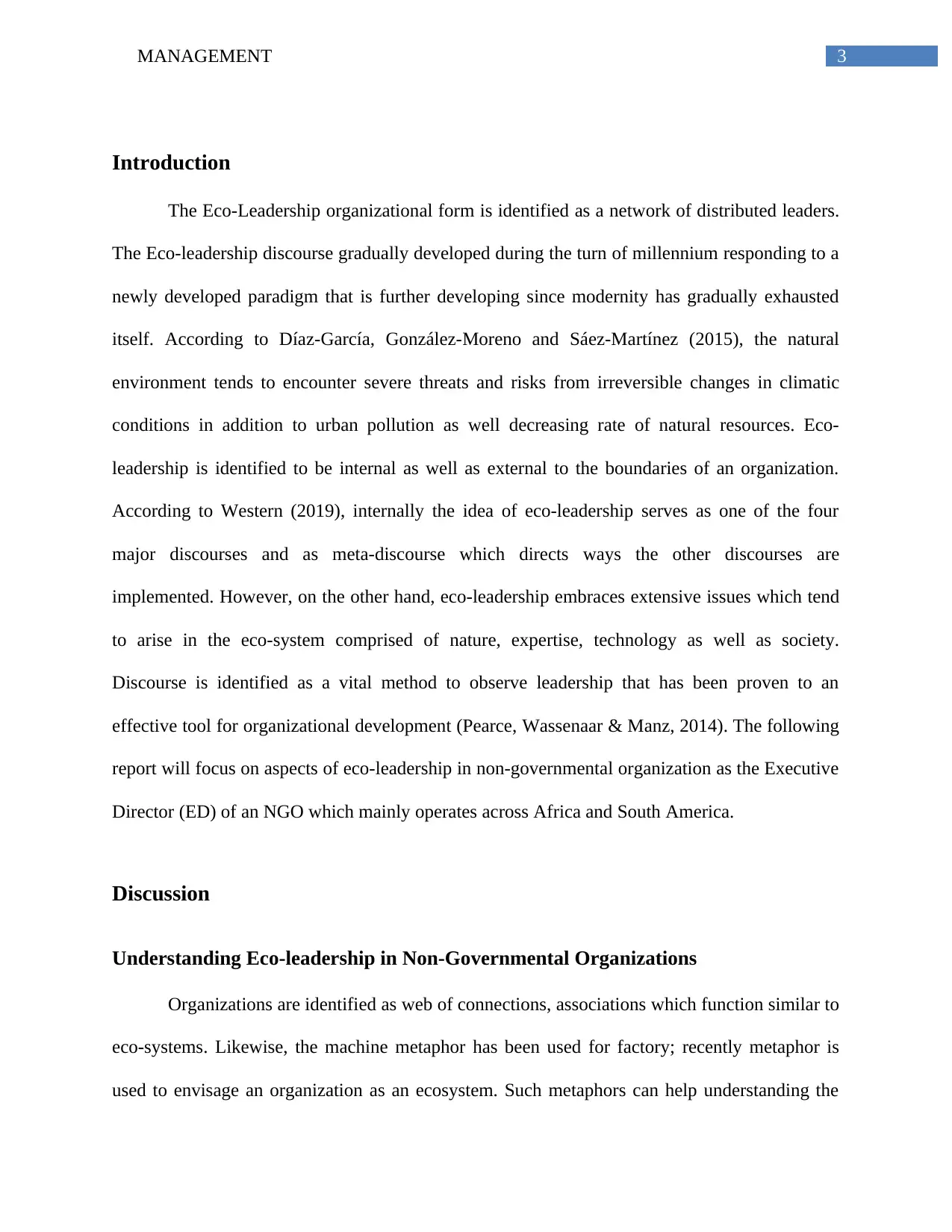
3MANAGEMENT
Introduction
The Eco-Leadership organizational form is identified as a network of distributed leaders.
The Eco-leadership discourse gradually developed during the turn of millennium responding to a
newly developed paradigm that is further developing since modernity has gradually exhausted
itself. According to Díaz-García, González-Moreno and Sáez-Martínez (2015), the natural
environment tends to encounter severe threats and risks from irreversible changes in climatic
conditions in addition to urban pollution as well decreasing rate of natural resources. Eco-
leadership is identified to be internal as well as external to the boundaries of an organization.
According to Western (2019), internally the idea of eco-leadership serves as one of the four
major discourses and as meta-discourse which directs ways the other discourses are
implemented. However, on the other hand, eco-leadership embraces extensive issues which tend
to arise in the eco-system comprised of nature, expertise, technology as well as society.
Discourse is identified as a vital method to observe leadership that has been proven to an
effective tool for organizational development (Pearce, Wassenaar & Manz, 2014). The following
report will focus on aspects of eco-leadership in non-governmental organization as the Executive
Director (ED) of an NGO which mainly operates across Africa and South America.
Discussion
Understanding Eco-leadership in Non-Governmental Organizations
Organizations are identified as web of connections, associations which function similar to
eco-systems. Likewise, the machine metaphor has been used for factory; recently metaphor is
used to envisage an organization as an ecosystem. Such metaphors can help understanding the
Introduction
The Eco-Leadership organizational form is identified as a network of distributed leaders.
The Eco-leadership discourse gradually developed during the turn of millennium responding to a
newly developed paradigm that is further developing since modernity has gradually exhausted
itself. According to Díaz-García, González-Moreno and Sáez-Martínez (2015), the natural
environment tends to encounter severe threats and risks from irreversible changes in climatic
conditions in addition to urban pollution as well decreasing rate of natural resources. Eco-
leadership is identified to be internal as well as external to the boundaries of an organization.
According to Western (2019), internally the idea of eco-leadership serves as one of the four
major discourses and as meta-discourse which directs ways the other discourses are
implemented. However, on the other hand, eco-leadership embraces extensive issues which tend
to arise in the eco-system comprised of nature, expertise, technology as well as society.
Discourse is identified as a vital method to observe leadership that has been proven to an
effective tool for organizational development (Pearce, Wassenaar & Manz, 2014). The following
report will focus on aspects of eco-leadership in non-governmental organization as the Executive
Director (ED) of an NGO which mainly operates across Africa and South America.
Discussion
Understanding Eco-leadership in Non-Governmental Organizations
Organizations are identified as web of connections, associations which function similar to
eco-systems. Likewise, the machine metaphor has been used for factory; recently metaphor is
used to envisage an organization as an ecosystem. Such metaphors can help understanding the
Paraphrase This Document
Need a fresh take? Get an instant paraphrase of this document with our AI Paraphraser
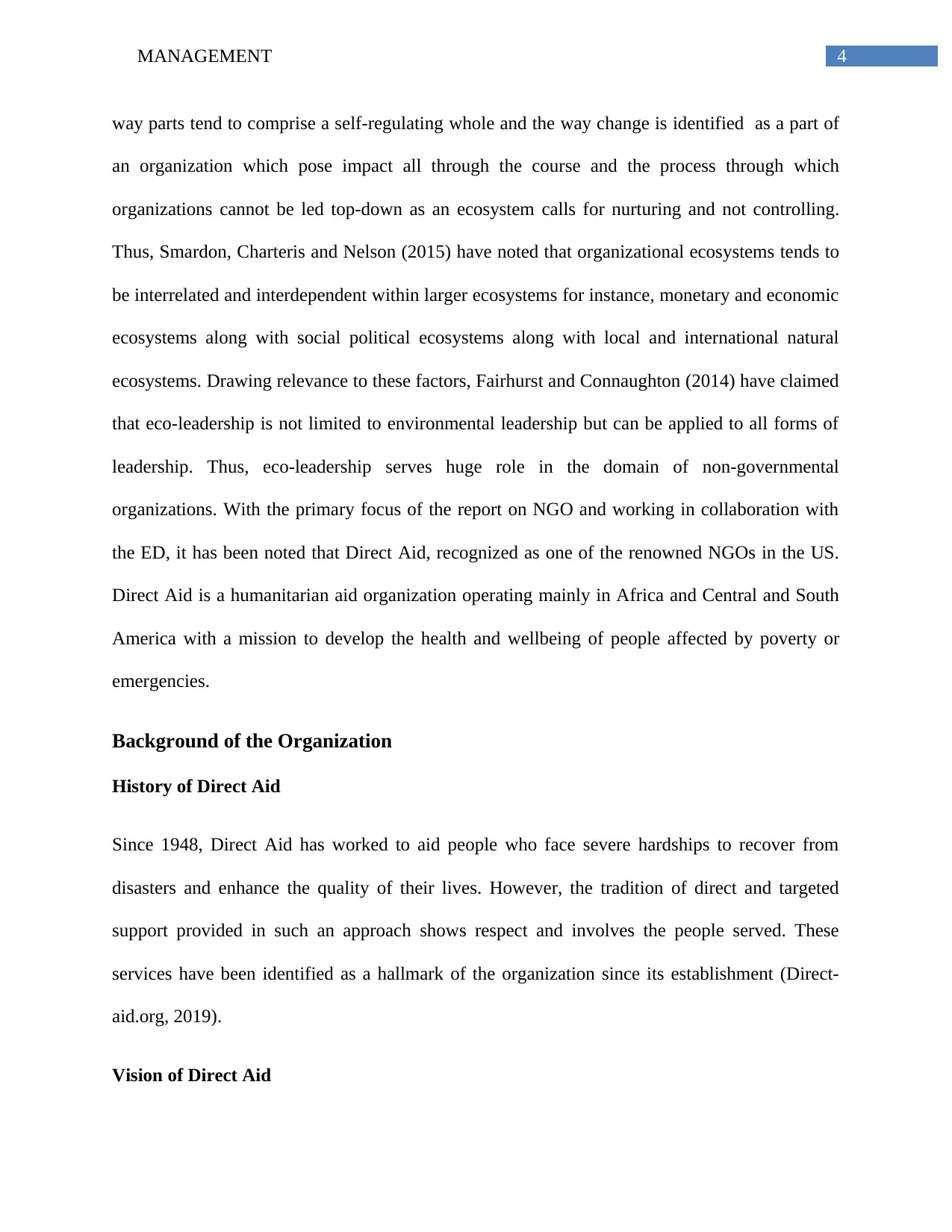
4MANAGEMENT
way parts tend to comprise a self-regulating whole and the way change is identified as a part of
an organization which pose impact all through the course and the process through which
organizations cannot be led top-down as an ecosystem calls for nurturing and not controlling.
Thus, Smardon, Charteris and Nelson (2015) have noted that organizational ecosystems tends to
be interrelated and interdependent within larger ecosystems for instance, monetary and economic
ecosystems along with social political ecosystems along with local and international natural
ecosystems. Drawing relevance to these factors, Fairhurst and Connaughton (2014) have claimed
that eco-leadership is not limited to environmental leadership but can be applied to all forms of
leadership. Thus, eco-leadership serves huge role in the domain of non-governmental
organizations. With the primary focus of the report on NGO and working in collaboration with
the ED, it has been noted that Direct Aid, recognized as one of the renowned NGOs in the US.
Direct Aid is a humanitarian aid organization operating mainly in Africa and Central and South
America with a mission to develop the health and wellbeing of people affected by poverty or
emergencies.
Background of the Organization
History of Direct Aid
Since 1948, Direct Aid has worked to aid people who face severe hardships to recover from
disasters and enhance the quality of their lives. However, the tradition of direct and targeted
support provided in such an approach shows respect and involves the people served. These
services have been identified as a hallmark of the organization since its establishment (Direct-
aid.org, 2019).
Vision of Direct Aid
way parts tend to comprise a self-regulating whole and the way change is identified as a part of
an organization which pose impact all through the course and the process through which
organizations cannot be led top-down as an ecosystem calls for nurturing and not controlling.
Thus, Smardon, Charteris and Nelson (2015) have noted that organizational ecosystems tends to
be interrelated and interdependent within larger ecosystems for instance, monetary and economic
ecosystems along with social political ecosystems along with local and international natural
ecosystems. Drawing relevance to these factors, Fairhurst and Connaughton (2014) have claimed
that eco-leadership is not limited to environmental leadership but can be applied to all forms of
leadership. Thus, eco-leadership serves huge role in the domain of non-governmental
organizations. With the primary focus of the report on NGO and working in collaboration with
the ED, it has been noted that Direct Aid, recognized as one of the renowned NGOs in the US.
Direct Aid is a humanitarian aid organization operating mainly in Africa and Central and South
America with a mission to develop the health and wellbeing of people affected by poverty or
emergencies.
Background of the Organization
History of Direct Aid
Since 1948, Direct Aid has worked to aid people who face severe hardships to recover from
disasters and enhance the quality of their lives. However, the tradition of direct and targeted
support provided in such an approach shows respect and involves the people served. These
services have been identified as a hallmark of the organization since its establishment (Direct-
aid.org, 2019).
Vision of Direct Aid
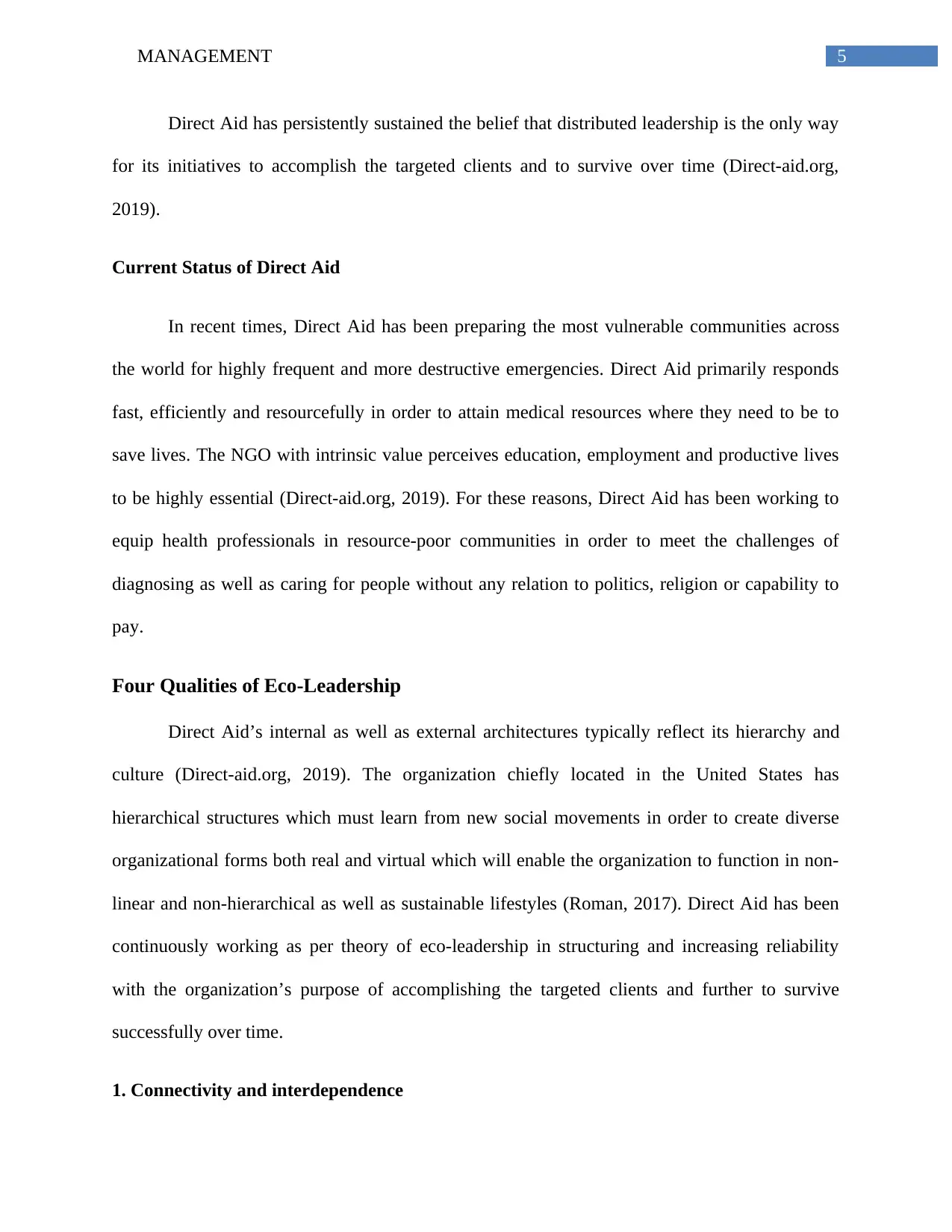
5MANAGEMENT
Direct Aid has persistently sustained the belief that distributed leadership is the only way
for its initiatives to accomplish the targeted clients and to survive over time (Direct-aid.org,
2019).
Current Status of Direct Aid
In recent times, Direct Aid has been preparing the most vulnerable communities across
the world for highly frequent and more destructive emergencies. Direct Aid primarily responds
fast, efficiently and resourcefully in order to attain medical resources where they need to be to
save lives. The NGO with intrinsic value perceives education, employment and productive lives
to be highly essential (Direct-aid.org, 2019). For these reasons, Direct Aid has been working to
equip health professionals in resource-poor communities in order to meet the challenges of
diagnosing as well as caring for people without any relation to politics, religion or capability to
pay.
Four Qualities of Eco-Leadership
Direct Aid’s internal as well as external architectures typically reflect its hierarchy and
culture (Direct-aid.org, 2019). The organization chiefly located in the United States has
hierarchical structures which must learn from new social movements in order to create diverse
organizational forms both real and virtual which will enable the organization to function in non-
linear and non-hierarchical as well as sustainable lifestyles (Roman, 2017). Direct Aid has been
continuously working as per theory of eco-leadership in structuring and increasing reliability
with the organization’s purpose of accomplishing the targeted clients and further to survive
successfully over time.
1. Connectivity and interdependence
Direct Aid has persistently sustained the belief that distributed leadership is the only way
for its initiatives to accomplish the targeted clients and to survive over time (Direct-aid.org,
2019).
Current Status of Direct Aid
In recent times, Direct Aid has been preparing the most vulnerable communities across
the world for highly frequent and more destructive emergencies. Direct Aid primarily responds
fast, efficiently and resourcefully in order to attain medical resources where they need to be to
save lives. The NGO with intrinsic value perceives education, employment and productive lives
to be highly essential (Direct-aid.org, 2019). For these reasons, Direct Aid has been working to
equip health professionals in resource-poor communities in order to meet the challenges of
diagnosing as well as caring for people without any relation to politics, religion or capability to
pay.
Four Qualities of Eco-Leadership
Direct Aid’s internal as well as external architectures typically reflect its hierarchy and
culture (Direct-aid.org, 2019). The organization chiefly located in the United States has
hierarchical structures which must learn from new social movements in order to create diverse
organizational forms both real and virtual which will enable the organization to function in non-
linear and non-hierarchical as well as sustainable lifestyles (Roman, 2017). Direct Aid has been
continuously working as per theory of eco-leadership in structuring and increasing reliability
with the organization’s purpose of accomplishing the targeted clients and further to survive
successfully over time.
1. Connectivity and interdependence
⊘ This is a preview!⊘
Do you want full access?
Subscribe today to unlock all pages.

Trusted by 1+ million students worldwide
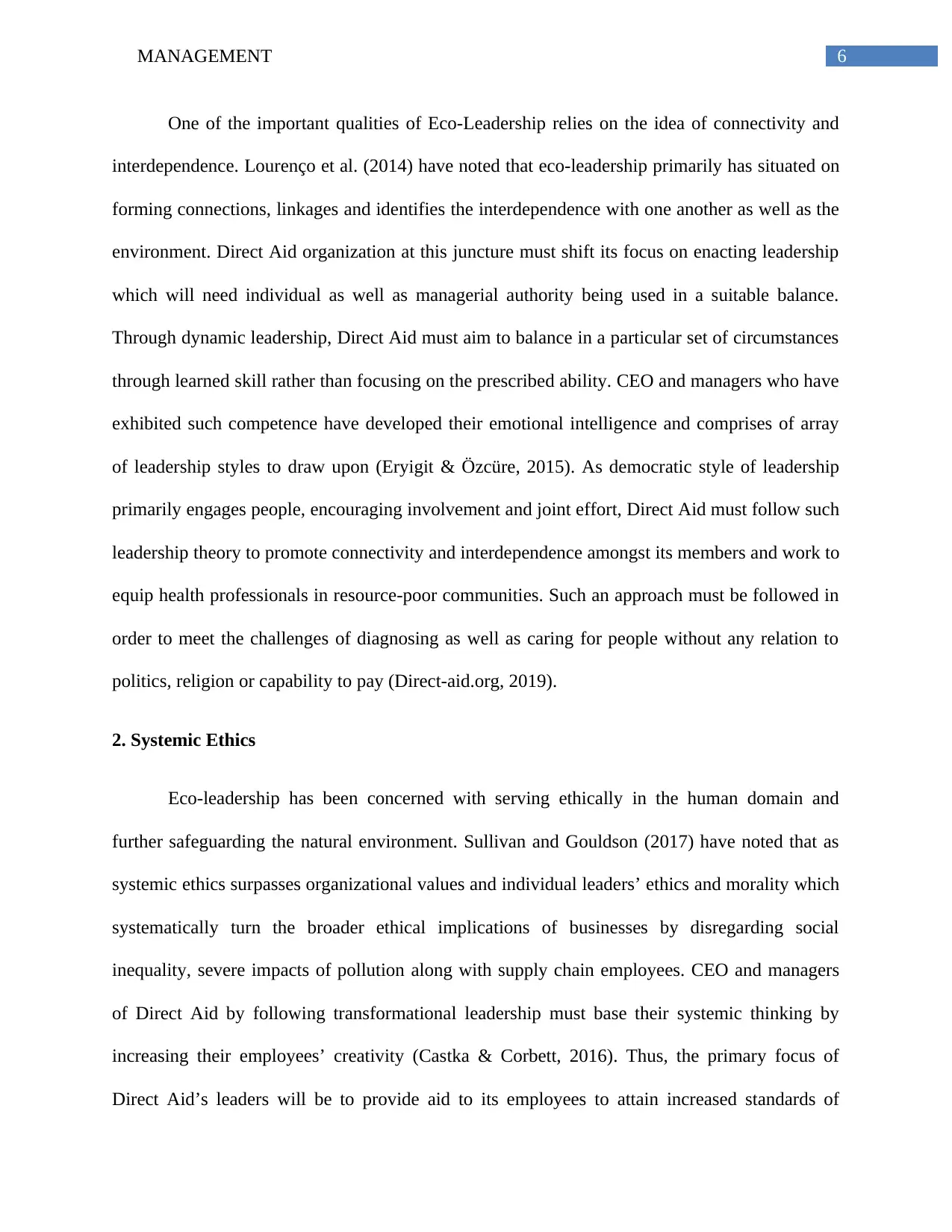
6MANAGEMENT
One of the important qualities of Eco-Leadership relies on the idea of connectivity and
interdependence. Lourenço et al. (2014) have noted that eco-leadership primarily has situated on
forming connections, linkages and identifies the interdependence with one another as well as the
environment. Direct Aid organization at this juncture must shift its focus on enacting leadership
which will need individual as well as managerial authority being used in a suitable balance.
Through dynamic leadership, Direct Aid must aim to balance in a particular set of circumstances
through learned skill rather than focusing on the prescribed ability. CEO and managers who have
exhibited such competence have developed their emotional intelligence and comprises of array
of leadership styles to draw upon (Eryigit & Özcüre, 2015). As democratic style of leadership
primarily engages people, encouraging involvement and joint effort, Direct Aid must follow such
leadership theory to promote connectivity and interdependence amongst its members and work to
equip health professionals in resource-poor communities. Such an approach must be followed in
order to meet the challenges of diagnosing as well as caring for people without any relation to
politics, religion or capability to pay (Direct-aid.org, 2019).
2. Systemic Ethics
Eco-leadership has been concerned with serving ethically in the human domain and
further safeguarding the natural environment. Sullivan and Gouldson (2017) have noted that as
systemic ethics surpasses organizational values and individual leaders’ ethics and morality which
systematically turn the broader ethical implications of businesses by disregarding social
inequality, severe impacts of pollution along with supply chain employees. CEO and managers
of Direct Aid by following transformational leadership must base their systemic thinking by
increasing their employees’ creativity (Castka & Corbett, 2016). Thus, the primary focus of
Direct Aid’s leaders will be to provide aid to its employees to attain increased standards of
One of the important qualities of Eco-Leadership relies on the idea of connectivity and
interdependence. Lourenço et al. (2014) have noted that eco-leadership primarily has situated on
forming connections, linkages and identifies the interdependence with one another as well as the
environment. Direct Aid organization at this juncture must shift its focus on enacting leadership
which will need individual as well as managerial authority being used in a suitable balance.
Through dynamic leadership, Direct Aid must aim to balance in a particular set of circumstances
through learned skill rather than focusing on the prescribed ability. CEO and managers who have
exhibited such competence have developed their emotional intelligence and comprises of array
of leadership styles to draw upon (Eryigit & Özcüre, 2015). As democratic style of leadership
primarily engages people, encouraging involvement and joint effort, Direct Aid must follow such
leadership theory to promote connectivity and interdependence amongst its members and work to
equip health professionals in resource-poor communities. Such an approach must be followed in
order to meet the challenges of diagnosing as well as caring for people without any relation to
politics, religion or capability to pay (Direct-aid.org, 2019).
2. Systemic Ethics
Eco-leadership has been concerned with serving ethically in the human domain and
further safeguarding the natural environment. Sullivan and Gouldson (2017) have noted that as
systemic ethics surpasses organizational values and individual leaders’ ethics and morality which
systematically turn the broader ethical implications of businesses by disregarding social
inequality, severe impacts of pollution along with supply chain employees. CEO and managers
of Direct Aid by following transformational leadership must base their systemic thinking by
increasing their employees’ creativity (Castka & Corbett, 2016). Thus, the primary focus of
Direct Aid’s leaders will be to provide aid to its employees to attain increased standards of
Paraphrase This Document
Need a fresh take? Get an instant paraphrase of this document with our AI Paraphraser
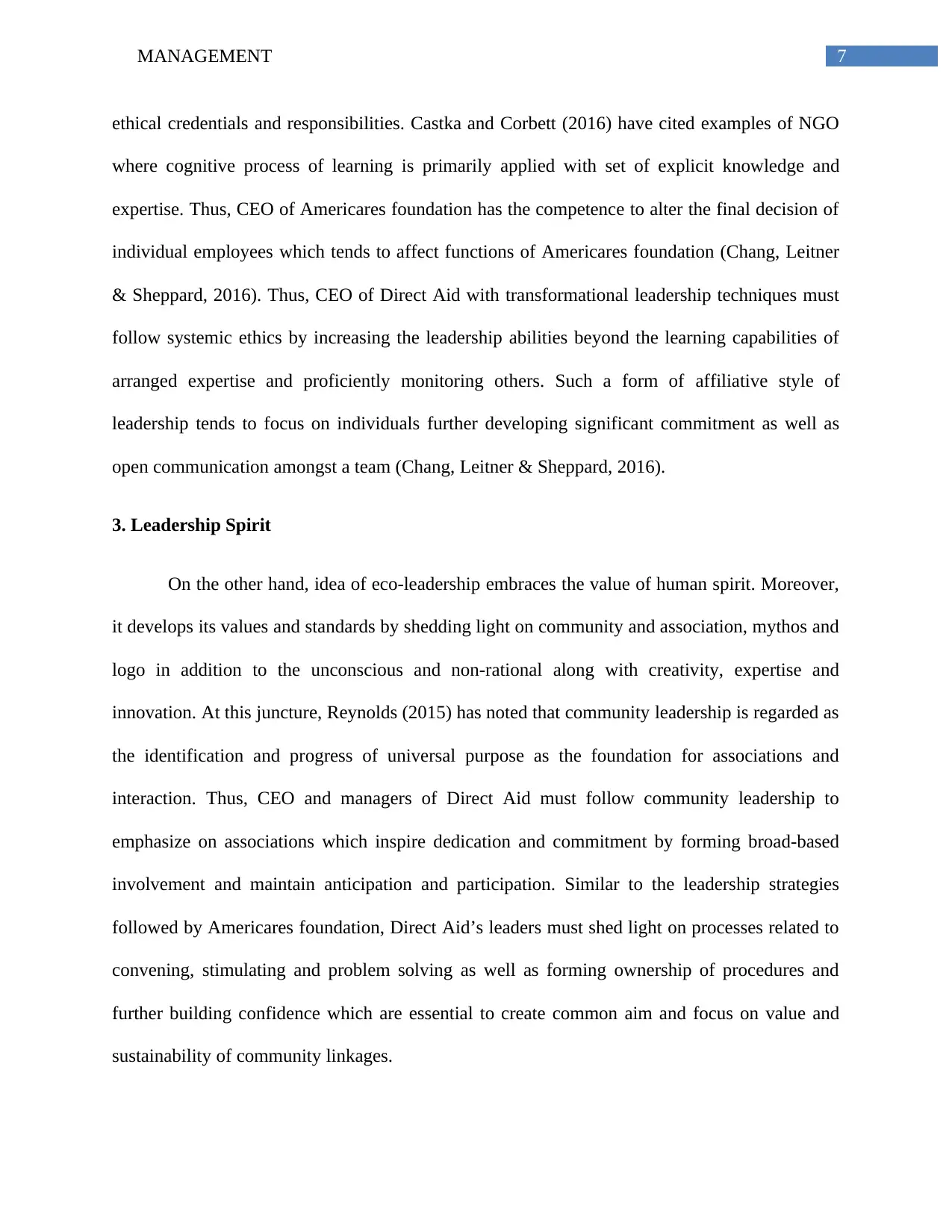
7MANAGEMENT
ethical credentials and responsibilities. Castka and Corbett (2016) have cited examples of NGO
where cognitive process of learning is primarily applied with set of explicit knowledge and
expertise. Thus, CEO of Americares foundation has the competence to alter the final decision of
individual employees which tends to affect functions of Americares foundation (Chang, Leitner
& Sheppard, 2016). Thus, CEO of Direct Aid with transformational leadership techniques must
follow systemic ethics by increasing the leadership abilities beyond the learning capabilities of
arranged expertise and proficiently monitoring others. Such a form of affiliative style of
leadership tends to focus on individuals further developing significant commitment as well as
open communication amongst a team (Chang, Leitner & Sheppard, 2016).
3. Leadership Spirit
On the other hand, idea of eco-leadership embraces the value of human spirit. Moreover,
it develops its values and standards by shedding light on community and association, mythos and
logo in addition to the unconscious and non-rational along with creativity, expertise and
innovation. At this juncture, Reynolds (2015) has noted that community leadership is regarded as
the identification and progress of universal purpose as the foundation for associations and
interaction. Thus, CEO and managers of Direct Aid must follow community leadership to
emphasize on associations which inspire dedication and commitment by forming broad-based
involvement and maintain anticipation and participation. Similar to the leadership strategies
followed by Americares foundation, Direct Aid’s leaders must shed light on processes related to
convening, stimulating and problem solving as well as forming ownership of procedures and
further building confidence which are essential to create common aim and focus on value and
sustainability of community linkages.
ethical credentials and responsibilities. Castka and Corbett (2016) have cited examples of NGO
where cognitive process of learning is primarily applied with set of explicit knowledge and
expertise. Thus, CEO of Americares foundation has the competence to alter the final decision of
individual employees which tends to affect functions of Americares foundation (Chang, Leitner
& Sheppard, 2016). Thus, CEO of Direct Aid with transformational leadership techniques must
follow systemic ethics by increasing the leadership abilities beyond the learning capabilities of
arranged expertise and proficiently monitoring others. Such a form of affiliative style of
leadership tends to focus on individuals further developing significant commitment as well as
open communication amongst a team (Chang, Leitner & Sheppard, 2016).
3. Leadership Spirit
On the other hand, idea of eco-leadership embraces the value of human spirit. Moreover,
it develops its values and standards by shedding light on community and association, mythos and
logo in addition to the unconscious and non-rational along with creativity, expertise and
innovation. At this juncture, Reynolds (2015) has noted that community leadership is regarded as
the identification and progress of universal purpose as the foundation for associations and
interaction. Thus, CEO and managers of Direct Aid must follow community leadership to
emphasize on associations which inspire dedication and commitment by forming broad-based
involvement and maintain anticipation and participation. Similar to the leadership strategies
followed by Americares foundation, Direct Aid’s leaders must shed light on processes related to
convening, stimulating and problem solving as well as forming ownership of procedures and
further building confidence which are essential to create common aim and focus on value and
sustainability of community linkages.
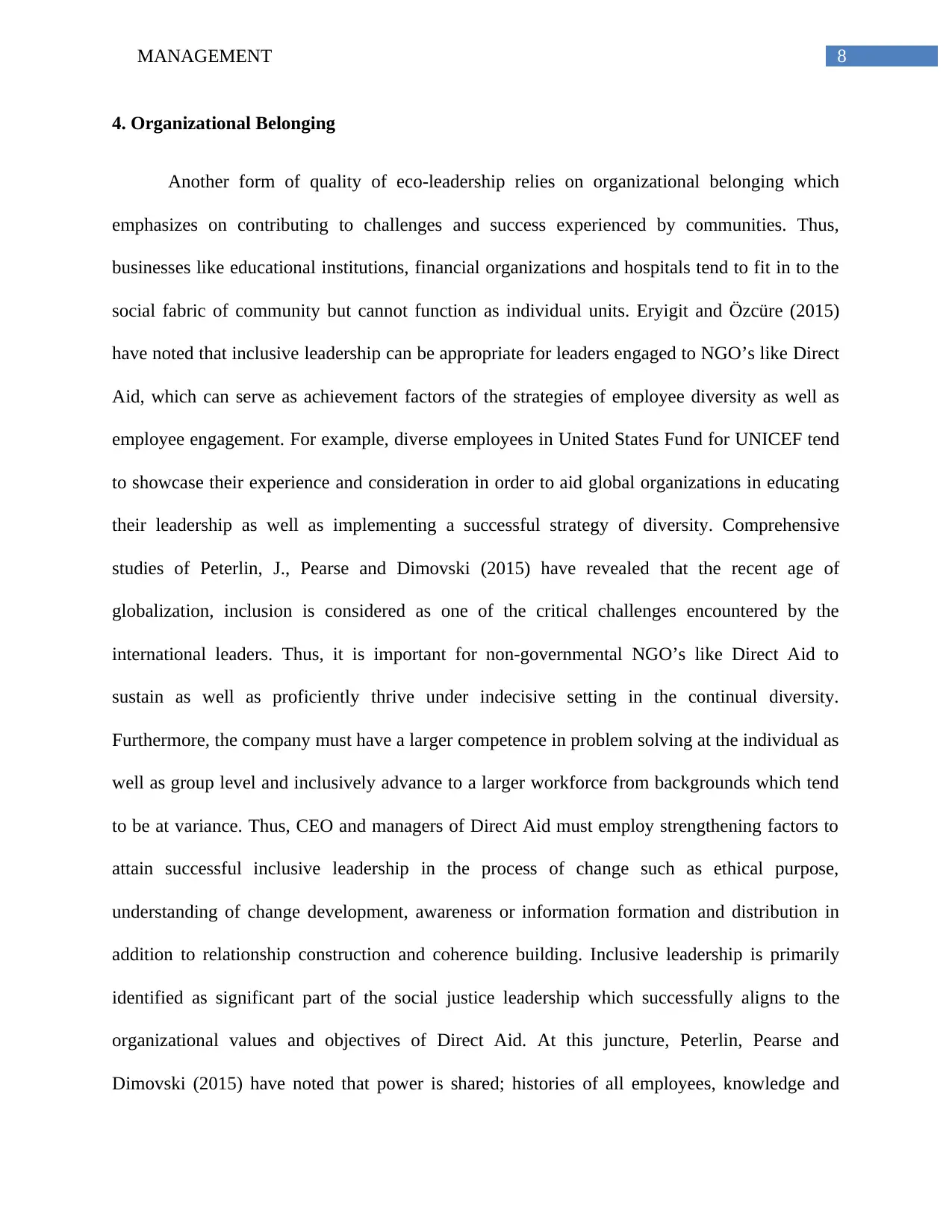
8MANAGEMENT
4. Organizational Belonging
Another form of quality of eco-leadership relies on organizational belonging which
emphasizes on contributing to challenges and success experienced by communities. Thus,
businesses like educational institutions, financial organizations and hospitals tend to fit in to the
social fabric of community but cannot function as individual units. Eryigit and Özcüre (2015)
have noted that inclusive leadership can be appropriate for leaders engaged to NGO’s like Direct
Aid, which can serve as achievement factors of the strategies of employee diversity as well as
employee engagement. For example, diverse employees in United States Fund for UNICEF tend
to showcase their experience and consideration in order to aid global organizations in educating
their leadership as well as implementing a successful strategy of diversity. Comprehensive
studies of Peterlin, J., Pearse and Dimovski (2015) have revealed that the recent age of
globalization, inclusion is considered as one of the critical challenges encountered by the
international leaders. Thus, it is important for non-governmental NGO’s like Direct Aid to
sustain as well as proficiently thrive under indecisive setting in the continual diversity.
Furthermore, the company must have a larger competence in problem solving at the individual as
well as group level and inclusively advance to a larger workforce from backgrounds which tend
to be at variance. Thus, CEO and managers of Direct Aid must employ strengthening factors to
attain successful inclusive leadership in the process of change such as ethical purpose,
understanding of change development, awareness or information formation and distribution in
addition to relationship construction and coherence building. Inclusive leadership is primarily
identified as significant part of the social justice leadership which successfully aligns to the
organizational values and objectives of Direct Aid. At this juncture, Peterlin, Pearse and
Dimovski (2015) have noted that power is shared; histories of all employees, knowledge and
4. Organizational Belonging
Another form of quality of eco-leadership relies on organizational belonging which
emphasizes on contributing to challenges and success experienced by communities. Thus,
businesses like educational institutions, financial organizations and hospitals tend to fit in to the
social fabric of community but cannot function as individual units. Eryigit and Özcüre (2015)
have noted that inclusive leadership can be appropriate for leaders engaged to NGO’s like Direct
Aid, which can serve as achievement factors of the strategies of employee diversity as well as
employee engagement. For example, diverse employees in United States Fund for UNICEF tend
to showcase their experience and consideration in order to aid global organizations in educating
their leadership as well as implementing a successful strategy of diversity. Comprehensive
studies of Peterlin, J., Pearse and Dimovski (2015) have revealed that the recent age of
globalization, inclusion is considered as one of the critical challenges encountered by the
international leaders. Thus, it is important for non-governmental NGO’s like Direct Aid to
sustain as well as proficiently thrive under indecisive setting in the continual diversity.
Furthermore, the company must have a larger competence in problem solving at the individual as
well as group level and inclusively advance to a larger workforce from backgrounds which tend
to be at variance. Thus, CEO and managers of Direct Aid must employ strengthening factors to
attain successful inclusive leadership in the process of change such as ethical purpose,
understanding of change development, awareness or information formation and distribution in
addition to relationship construction and coherence building. Inclusive leadership is primarily
identified as significant part of the social justice leadership which successfully aligns to the
organizational values and objectives of Direct Aid. At this juncture, Peterlin, Pearse and
Dimovski (2015) have noted that power is shared; histories of all employees, knowledge and
⊘ This is a preview!⊘
Do you want full access?
Subscribe today to unlock all pages.

Trusted by 1+ million students worldwide
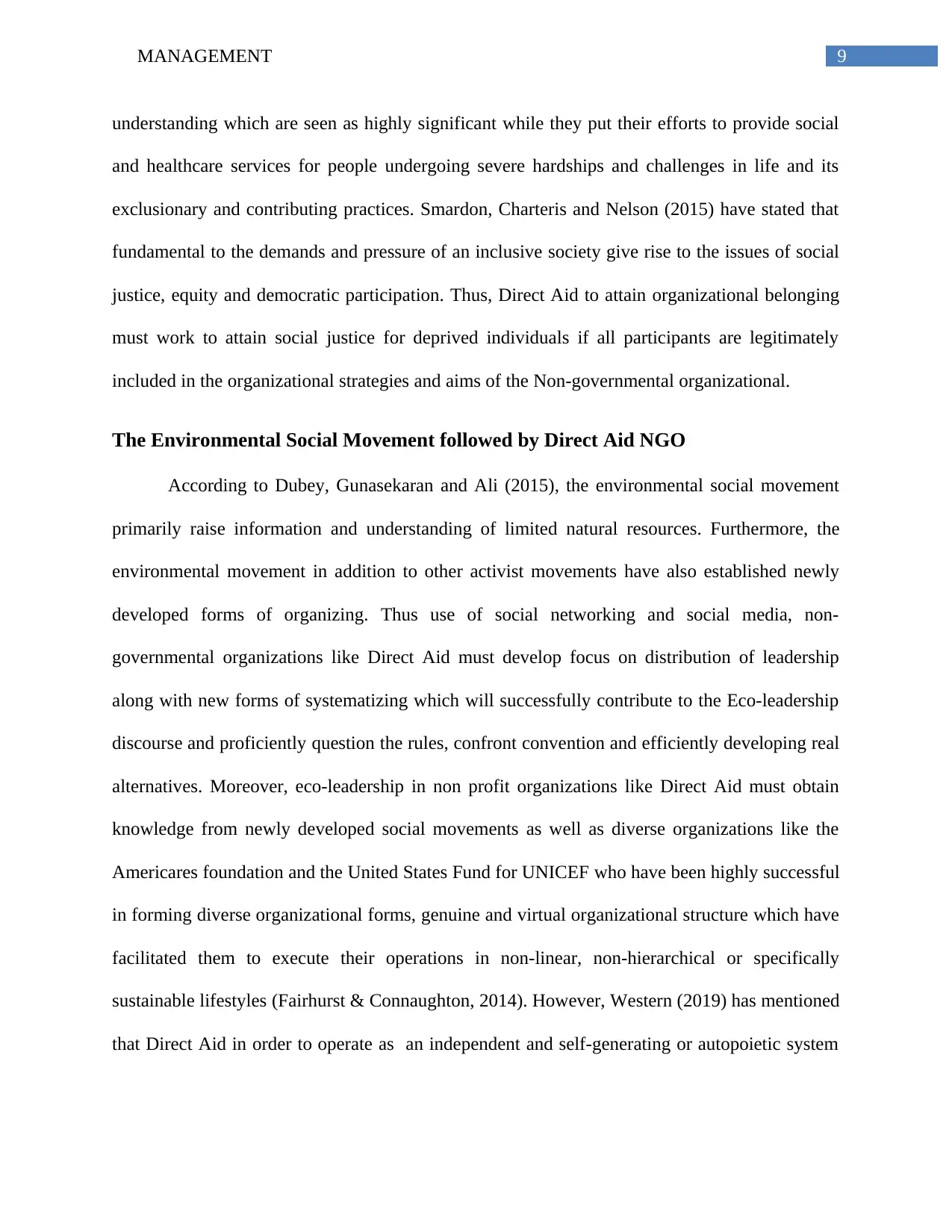
9MANAGEMENT
understanding which are seen as highly significant while they put their efforts to provide social
and healthcare services for people undergoing severe hardships and challenges in life and its
exclusionary and contributing practices. Smardon, Charteris and Nelson (2015) have stated that
fundamental to the demands and pressure of an inclusive society give rise to the issues of social
justice, equity and democratic participation. Thus, Direct Aid to attain organizational belonging
must work to attain social justice for deprived individuals if all participants are legitimately
included in the organizational strategies and aims of the Non-governmental organizational.
The Environmental Social Movement followed by Direct Aid NGO
According to Dubey, Gunasekaran and Ali (2015), the environmental social movement
primarily raise information and understanding of limited natural resources. Furthermore, the
environmental movement in addition to other activist movements have also established newly
developed forms of organizing. Thus use of social networking and social media, non-
governmental organizations like Direct Aid must develop focus on distribution of leadership
along with new forms of systematizing which will successfully contribute to the Eco-leadership
discourse and proficiently question the rules, confront convention and efficiently developing real
alternatives. Moreover, eco-leadership in non profit organizations like Direct Aid must obtain
knowledge from newly developed social movements as well as diverse organizations like the
Americares foundation and the United States Fund for UNICEF who have been highly successful
in forming diverse organizational forms, genuine and virtual organizational structure which have
facilitated them to execute their operations in non-linear, non-hierarchical or specifically
sustainable lifestyles (Fairhurst & Connaughton, 2014). However, Western (2019) has mentioned
that Direct Aid in order to operate as an independent and self-generating or autopoietic system
understanding which are seen as highly significant while they put their efforts to provide social
and healthcare services for people undergoing severe hardships and challenges in life and its
exclusionary and contributing practices. Smardon, Charteris and Nelson (2015) have stated that
fundamental to the demands and pressure of an inclusive society give rise to the issues of social
justice, equity and democratic participation. Thus, Direct Aid to attain organizational belonging
must work to attain social justice for deprived individuals if all participants are legitimately
included in the organizational strategies and aims of the Non-governmental organizational.
The Environmental Social Movement followed by Direct Aid NGO
According to Dubey, Gunasekaran and Ali (2015), the environmental social movement
primarily raise information and understanding of limited natural resources. Furthermore, the
environmental movement in addition to other activist movements have also established newly
developed forms of organizing. Thus use of social networking and social media, non-
governmental organizations like Direct Aid must develop focus on distribution of leadership
along with new forms of systematizing which will successfully contribute to the Eco-leadership
discourse and proficiently question the rules, confront convention and efficiently developing real
alternatives. Moreover, eco-leadership in non profit organizations like Direct Aid must obtain
knowledge from newly developed social movements as well as diverse organizations like the
Americares foundation and the United States Fund for UNICEF who have been highly successful
in forming diverse organizational forms, genuine and virtual organizational structure which have
facilitated them to execute their operations in non-linear, non-hierarchical or specifically
sustainable lifestyles (Fairhurst & Connaughton, 2014). However, Western (2019) has mentioned
that Direct Aid in order to operate as an independent and self-generating or autopoietic system
Paraphrase This Document
Need a fresh take? Get an instant paraphrase of this document with our AI Paraphraser
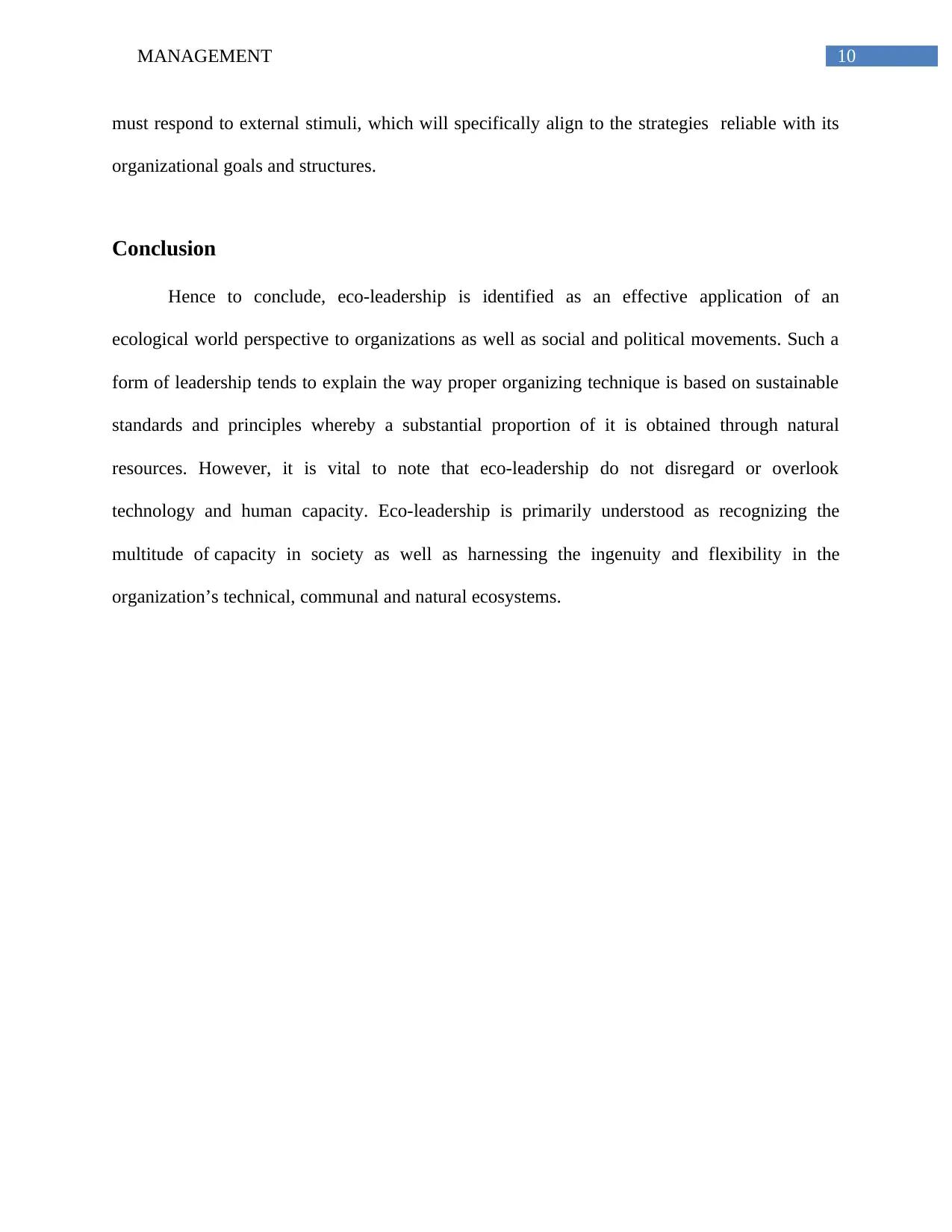
10MANAGEMENT
must respond to external stimuli, which will specifically align to the strategies reliable with its
organizational goals and structures.
Conclusion
Hence to conclude, eco-leadership is identified as an effective application of an
ecological world perspective to organizations as well as social and political movements. Such a
form of leadership tends to explain the way proper organizing technique is based on sustainable
standards and principles whereby a substantial proportion of it is obtained through natural
resources. However, it is vital to note that eco-leadership do not disregard or overlook
technology and human capacity. Eco-leadership is primarily understood as recognizing the
multitude of capacity in society as well as harnessing the ingenuity and flexibility in the
organization’s technical, communal and natural ecosystems.
must respond to external stimuli, which will specifically align to the strategies reliable with its
organizational goals and structures.
Conclusion
Hence to conclude, eco-leadership is identified as an effective application of an
ecological world perspective to organizations as well as social and political movements. Such a
form of leadership tends to explain the way proper organizing technique is based on sustainable
standards and principles whereby a substantial proportion of it is obtained through natural
resources. However, it is vital to note that eco-leadership do not disregard or overlook
technology and human capacity. Eco-leadership is primarily understood as recognizing the
multitude of capacity in society as well as harnessing the ingenuity and flexibility in the
organization’s technical, communal and natural ecosystems.
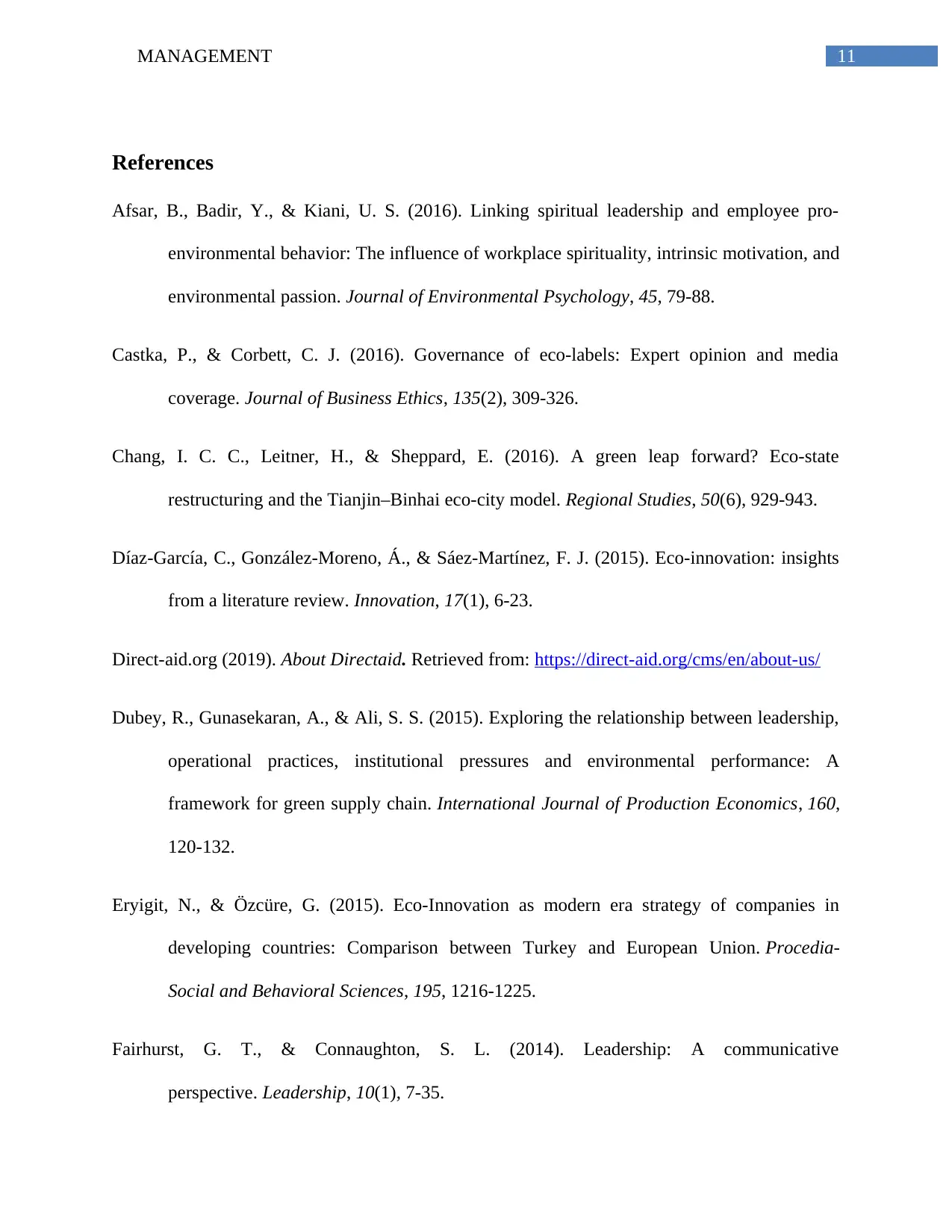
11MANAGEMENT
References
Afsar, B., Badir, Y., & Kiani, U. S. (2016). Linking spiritual leadership and employee pro-
environmental behavior: The influence of workplace spirituality, intrinsic motivation, and
environmental passion. Journal of Environmental Psychology, 45, 79-88.
Castka, P., & Corbett, C. J. (2016). Governance of eco-labels: Expert opinion and media
coverage. Journal of Business Ethics, 135(2), 309-326.
Chang, I. C. C., Leitner, H., & Sheppard, E. (2016). A green leap forward? Eco-state
restructuring and the Tianjin–Binhai eco-city model. Regional Studies, 50(6), 929-943.
Díaz-García, C., González-Moreno, Á., & Sáez-Martínez, F. J. (2015). Eco-innovation: insights
from a literature review. Innovation, 17(1), 6-23.
Direct-aid.org (2019). About Directaid. Retrieved from: https://direct-aid.org/cms/en/about-us/
Dubey, R., Gunasekaran, A., & Ali, S. S. (2015). Exploring the relationship between leadership,
operational practices, institutional pressures and environmental performance: A
framework for green supply chain. International Journal of Production Economics, 160,
120-132.
Eryigit, N., & Özcüre, G. (2015). Eco-Innovation as modern era strategy of companies in
developing countries: Comparison between Turkey and European Union. Procedia-
Social and Behavioral Sciences, 195, 1216-1225.
Fairhurst, G. T., & Connaughton, S. L. (2014). Leadership: A communicative
perspective. Leadership, 10(1), 7-35.
References
Afsar, B., Badir, Y., & Kiani, U. S. (2016). Linking spiritual leadership and employee pro-
environmental behavior: The influence of workplace spirituality, intrinsic motivation, and
environmental passion. Journal of Environmental Psychology, 45, 79-88.
Castka, P., & Corbett, C. J. (2016). Governance of eco-labels: Expert opinion and media
coverage. Journal of Business Ethics, 135(2), 309-326.
Chang, I. C. C., Leitner, H., & Sheppard, E. (2016). A green leap forward? Eco-state
restructuring and the Tianjin–Binhai eco-city model. Regional Studies, 50(6), 929-943.
Díaz-García, C., González-Moreno, Á., & Sáez-Martínez, F. J. (2015). Eco-innovation: insights
from a literature review. Innovation, 17(1), 6-23.
Direct-aid.org (2019). About Directaid. Retrieved from: https://direct-aid.org/cms/en/about-us/
Dubey, R., Gunasekaran, A., & Ali, S. S. (2015). Exploring the relationship between leadership,
operational practices, institutional pressures and environmental performance: A
framework for green supply chain. International Journal of Production Economics, 160,
120-132.
Eryigit, N., & Özcüre, G. (2015). Eco-Innovation as modern era strategy of companies in
developing countries: Comparison between Turkey and European Union. Procedia-
Social and Behavioral Sciences, 195, 1216-1225.
Fairhurst, G. T., & Connaughton, S. L. (2014). Leadership: A communicative
perspective. Leadership, 10(1), 7-35.
⊘ This is a preview!⊘
Do you want full access?
Subscribe today to unlock all pages.

Trusted by 1+ million students worldwide
1 out of 13
Related Documents
Your All-in-One AI-Powered Toolkit for Academic Success.
+13062052269
info@desklib.com
Available 24*7 on WhatsApp / Email
![[object Object]](/_next/static/media/star-bottom.7253800d.svg)
Unlock your academic potential
Copyright © 2020–2025 A2Z Services. All Rights Reserved. Developed and managed by ZUCOL.



